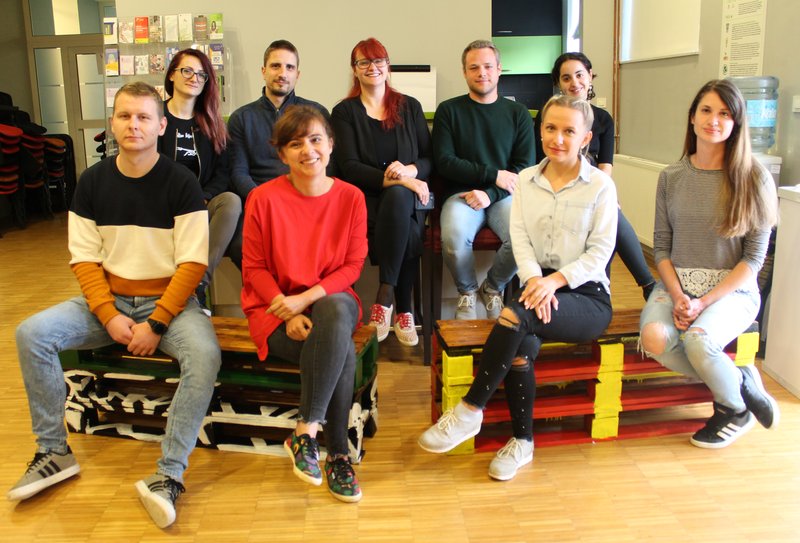Idea Challenge Winner in the Spotlight: Take the Money, and Do Something for the Youth
![IMG_6918_Fotor[5]](https://civic-europe.eu/liquid/im_/https://ce-media.liqd.net/images/uzmipare1.width-770.jpg)
Workshop on rules of participatory budgeting (photo by LAG).
Take the Money, and Do Something for the Youth introduced youth in the different municipalities to participatory budgeting, which is a tool that empowers people to decide together how to spend public money. Learn more about their project idea, where it was implemented, the successes and challenges, and their main takeaways from implementing such a project for youth in the following interview.
Where in Croatia does your organization LAG work?
The project idea Take the Money, and Do Something for the Youth was implemented in Krapina-Zagorje County consisting of 11 municipalities and cities with a total population of 44 thousand. Our organization’s primary focus is to safeguard the quality of life of the rural population in our region. We are developing our area through public calls for investment to improve or expand basic services for the population, including leisure and cultural activities and essential infrastructures such as calls for local farmers to improve their own production.
What were the local challenges that your project idea tried to overcome?
We are very involved in rural development, but most of the communities' actions are focused on the adult population, while young people are left out of more serious community involvement. The general perception of youth among decision-makers is often simple: “They are a problem.” We wanted to change that with the project Take the Money, and Do Something for the Youth by showing decision makers that young people are a resource that can offer the community far more than they think.
How did you approach solving those challenges?
By introducing participatory budgeting methods to youth, we wanted to give them the opportunity to express their wishes, opinions, and needs, and bring decision-makers closer to young people in the area. Our main aim was to connect youth and decision-makers and to introduce young people to the processes of public administration for them to be seen, heard, and understood.
![IMG_6145[77]](https://civic-europe.eu/liquid/im_/https://ce-media.liqd.net/images/IMG_614577.width-800.jpg)
Competition for youngster's votes in the municipality of Pregrada (photo by LAG).
How did you come up with the project idea and what is special about it?
The project idea was born from a simple proposition: Youth do not participate enough in decision-making processes and are not involved enough in community life. Youth is not to blame; the governing structures do not allow them to participate and to be involved. We believe that introducing participatory budgeting to youth is a good opportunity to give them the possibility to participate in the community and shape community life with their ideas. Our former manager, Tajana Broz, saw a similar example of participatory budgeting for youth when she was on a study trip in Portugal. She quickly realized that youth, decision-makers, and the whole community would benefit from supporting youth to implement their ideas that would tackle problems in their community.
Our project idea stands out as it is one of its kind in Croatia. Until now, we do not know of any other municipalities using this approach in our country. Currently, we also started transferring knowledge to several other municipalities in Croatia that are interested in implementing participatory budgeting in the same way. Ultimately, introducing participatory budgeting to youth is not only and exclusively a process where young people present their ideas, but is a process of working with young people that requires a lot of time and understanding.
![IMG_7041[20]](https://civic-europe.eu/liquid/im_/https://ce-media.liqd.net/images/IMG_704120.width-800.jpg)
Youth preparing to pitch their idea for the construction of a sand volleyball court in the municipality of Desiníc (photo by LAG).
What happened after you finished your journey with Civic Europe?
We continue to implement the project with the support of the Association Zagor. One of our main achievements after Civic Europe and is that we are now implementing the project with full funding of municipalities and cities. We hope that the project will continue in the future, and we believe we have succeeded in raising awareness among decision-makers about the importance of involving youth in community life and action.
Are there any key learnings that you want to share with us from the implementation?
I think we learned how to be patient and how to deal with unforeseen situations. Sometimes we can’t influence everyone and everything, but for the things we can influence we have to do our best to realize them to the best of our ability.
![IMG_6918_Fotor[5]](https://civic-europe.eu/liquid/im_/https://ce-media.liqd.net/images/IMG_6918_Fotor5.width-800.jpg)
Voting ballot (photo by LAG).
How did Civic Europe support you and what does it mean to you?
It would be great if more organizations were like Civic Europe. Not only providing funding for projects, but also offering various capacity-building activities as they did. In addition, from our experience, donors often ask only for numbers, since they are not so much interested in the process. We believe that quality work comes from the whole process and not just the numbers we anticipated when we wrote the project plan. We were very glad to learn that Civic Europe was more a partner instead of a donor who was interested in whether we managed to implement the project – despite all the challenges, internal and external.

The project team of Take the Money, and Do Something for the Youth (photo by LAG).
What is your wish for the future?
We would be happy if this participatory budgeting project became recognized at the national level or even an obligation for all municipalities and cities.
Do you want to learn more about LAG, the project, and its creators? You can read their full project journey here.
Special thanks to Hrvoje Novak and his team for participating in this interview.